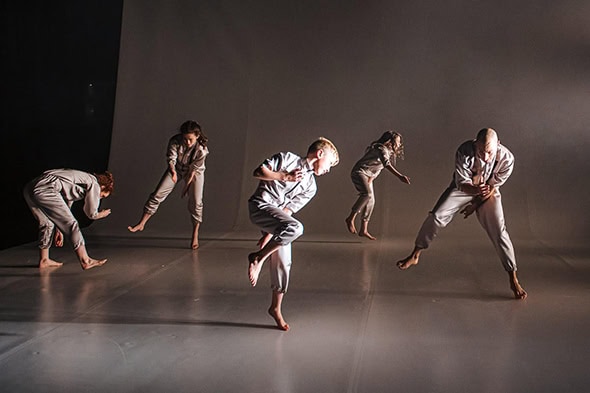Compagnie Maguy Marin, May B, Sadler’s Wells
Posted: July 13th, 2024 | Author: Nicholas Minns | Filed under: Performance | Tags: Albin Chavignon, Franz Schubert, Gavin Bryars, Gilles de Binche, Louise Marin, Maguy Marin, Samuel Beckett, Sue Jones | Comments Off on Compagnie Maguy Marin, May B, Sadler’s WellsCompagnie Maguy Marin, May B, Sadler’s Wells, May 22, 2024

Maguy Marin’s May B, presented at Sadler’s Wells on May 21 and 22, is divided into three contrasting sections, each influenced by the works of Samuel Beckett. One doesn’t necessarily think of Beckett and dance in the same breath, but as Sue Jones explains in her article published by Dance Research, ‘Beckett’s Brush with Ballet’, the playwright became fascinated with the mimetic aspect of dance after seeing Léonide Massine as the puppet in Petrouchka in 1934. Beckett was later to work with the dancer Deryk Mendel, for whom he wrote the one act mime play Act Without Words in 1956. Other actors with whom he worked have described his directorial insistence on the rhythm and timing of gestures as ‘choreography’, so it is perhaps not so surprising that when Marin wrote to Beckett for permission to use his plays as a basis for her new work, she was not only invited to meet with him but received Beckett’s wholehearted endorsement for her project.
Marin’s May B borrows from Beckett’s stagecraft the almost claustrophobic enclosed space of the stage — similar to Petrouchka’s cell — and imbues it with elements of Beckett’s choreography as in the rhythmical, shuffling steps of the dancers in the opening section. The ten dancers move sometimes as one, each with their individuality but dependent on the group; squabbling, testiness and greed coexist with moments of friendship, love and lust. There is the bitter humour of the oppressed, the sense of the absurdity of life, and of endless entrances and departures. The stage design, the lighting (by Albin Chavignon), the costumes (by Louise Marin) and the exaggerated makeup are all integral to the choreography, and Marin’s use of music by Franz Schubert, the raunchy street music of Gilles de Binche and, in the third section, Gavin Bryars’ Jesus’ Love Never Failed Me Yet contributes to the layering of the work’s emotional power.
May B was first performed in 1981. Looking back at a filmed version from that year, it is apparent that the integrity of the work has not suffered over time and that the current performers have the maturity and sensibility to maintain the qualities of the original. What has changed, perhaps, is the context of the work in relation to the present time. May B is bleak in rendering the despair of helplessness and powerlessness, emotions that are currently evident in our environment, at home and abroad, but which are either sanitised by the media or muted to the point of silence by political deviance. The theatre is one of the few places where the perilous state of humanity can be depicted, albeit in notional form, but such a theatrical work has to meet its audience head on to provoke a response. There was a perceptible sense at Sadler’s Wells that the work was appreciated on a superficial level but that its understated savagery failed to break through the expectations of current commercial theatre.

Marin was brought up in a politically active family, and her political vision has always co-existed with her stage practice. At Sadler’s Wells this political activism came up against a cultural obstacle. Following recent performances in Europe of May B, Marin has read her statement on the aggression on Gaza by the State of Israel; she has done so without hindrance from the venues, but the director of Sadler’s Wells, Sir Alistair Spalding, prohibited her from reading it, saying an artist’s message should be expressed in the work and citing neutrality and audience concerns. According to Maguy Marin company president, Antoine Manologlou, Marin’s message included a specific reference to one of Sadler’s Wells’ sponsors, Barclays Bank, that among its investments supports the purchase of arms in Israel. When Marin and members of her company defiantly handed out her statement on printed flyers to the audience as they left the theatre on May 22, security staff intervened aggressively to prevent the action.
The irony is that the imagery of May B — the discarded shoes, the suitcases, the hunger, the despair — implicitly refers to the deprivations of refugees as well as victims of holocaust. There is no shortage of explicit support for the victims of the Jewish Holocaust in museums, works of art, films and public memorials, but solidarity with other victims of oppression and genocide are less openly encouraged. One might argue, as Spalding evidently did, that the work should speak for itself, but that is to hide, in this particular instance, the complicity of the presenter. Marin’s activism extended logically from the work to bring its implicit message into the realm of contemporary politics. Her defiance came from the integrity of the artist, and its attempted repression represents the perversity of cultural authority.
